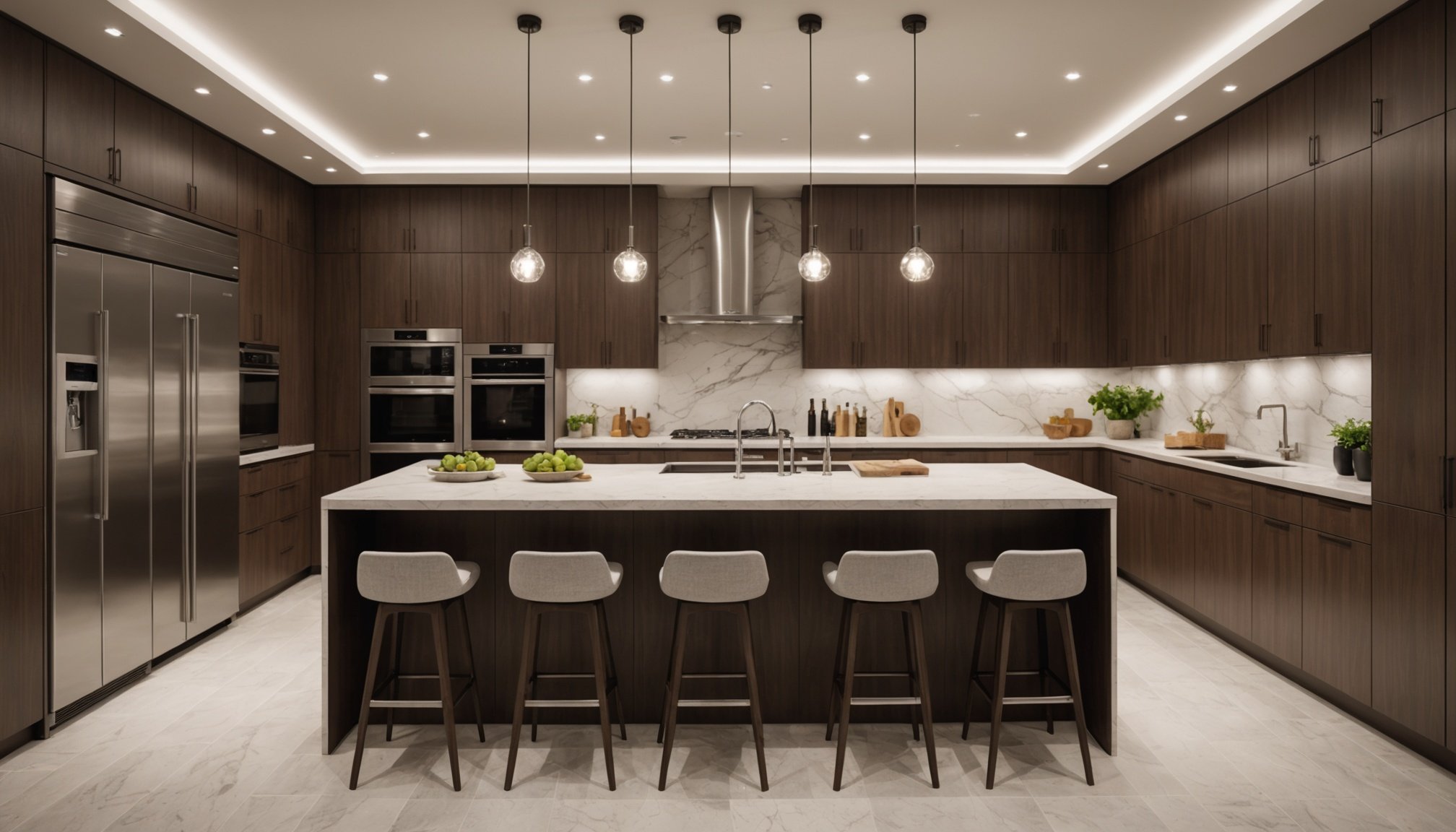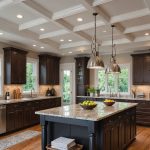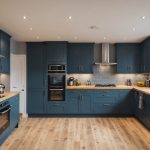Lighting can transform your kitchen from a mundane space to a vibrant culinary haven. The right blend of natural and artificial light creates an inviting atmosphere, enhances functionality, and highlights your design choices. Discover innovative techniques to harmonize these light sources, ensuring your kitchen is both practical and aesthetically pleasing. Explore how to balance aesthetics with utility, making your kitchen a warm and welcoming hub for family and friends. Unveil the secrets to mastering kitchen illumination and elevate your cooking experience to new heights.
Understanding the Importance of Kitchen Lighting
Kitchen lighting plays a crucial role in enhancing both the functionality and overall experience of this essential space. Proper lighting ensures that tasks such as cooking, cleaning, and food preparation are performed safely and efficiently. It is vital for illuminating work surfaces, reducing eye strain, and preventing accidents.
Topic to read : Mastering UK Building Regulations: A Comprehensive Guide for Your Kitchen Renovation
Moreover, lighting significantly impacts the mood and ambiance of the kitchen. The right lighting can transform a kitchen from a purely functional area to a warm and inviting space, perfect for family gatherings or entertaining guests. It can highlight design elements, create focal points, and add depth to the room.
Achieving the right balance between natural and artificial light is key to optimizing kitchen lighting. Natural light provides a bright and cheerful atmosphere during the day, while artificial light supplements and enhances visibility when natural light diminishes. Combining various lighting types, such as task, ambient, and accent lighting, helps create a versatile and adaptable environment.
Also to read : Mastering Kitchen Design: Expert Tips to Effectively Minimize Cooking Odors
In summary, understanding the importance of kitchen lighting involves recognizing its impact on functionality, mood, and the balance between natural and artificial sources. Properly planned lighting can significantly enhance the kitchen's usability and aesthetic appeal.
Maximizing Natural Light in the Kitchen
Enhancing natural light in the kitchen can transform it into a bright and inviting space. By thoughtfully considering architectural elements and design strategies, you can significantly improve the natural light flow.
Architectural Considerations
- Window placement and size are crucial in maximizing natural light. Large windows or strategically placed ones can flood your kitchen with daylight. Consider using skylights and light tubes to channel sunlight into darker areas of the kitchen. These features can brighten the space without taking up wall space.
- Incorporating reflective surfaces like glossy countertops or metallic backsplashes can further enhance brightness by bouncing light around the room.
Design Strategies
- Opt for light-colored materials and finishes, such as white or pastel cabinets and walls, to reflect light and create an airy atmosphere.
- Open shelving instead of closed cabinets allows light to flow freely and makes the space feel less cluttered.
- Glass doors and panels can be used to separate spaces without blocking light, maintaining an open feel.
Seasonal Adjustments
- Window treatments like sheer curtains or blinds can help control light levels while preserving privacy.
- Consider adding seasonal plants that thrive in natural light, contributing to a lively kitchen environment.
Selecting Artificial Lighting Options
Choosing the right artificial kitchen lighting can transform your kitchen into a more functional and inviting space. Understanding the various types and how to integrate them effectively is key.
Types of Artificial Lighting
Artificial kitchen lighting can be divided into three main types: ambient, task, and accent lighting. Ambient lighting provides overall illumination, often through ceiling fixtures or recessed lights. Task lighting focuses on specific work areas, such as under-cabinet lights for countertops. Accent lighting highlights design features, like a pendant light over an island. Integrating smart lighting solutions, such as app-controlled LED strips, can offer convenience and adaptability.
Choosing the Right Bulbs
Selecting bulbs involves understanding color temperature, which affects the room's mood. Warm white bulbs (2700K-3000K) create a cozy atmosphere, while cool white (3500K-4100K) enhances focus. Opt for energy-efficient options, like LED bulbs, which offer longevity and reduced energy consumption. Consider bulbs with dimming capabilities to adjust the light intensity for different occasions.
Layering Lighting for Effect
Layering lighting involves combining different types to create depth and interest. Use techniques like highlighting specific areas with spotlights or creating focal points with pendant lights. This approach ensures a well-lit kitchen that meets both functional and aesthetic needs.
Examples of Successful Kitchen Illumination
Exploring kitchen illumination examples can provide valuable insights into creating a well-lit and inviting kitchen space. By examining case studies and transformations, you can draw inspiration from professional designers and chefs who have mastered the art of kitchen lighting.
Case Studies of Well-Lit Kitchen Designs
In one notable case, a professional chef collaborated with a designer to transform a dimly lit kitchen into a culinary haven. By incorporating a combination of task and ambient lighting, the kitchen was transformed into a functional and aesthetically pleasing space. The use of pendant lights over the island and under-cabinet lighting ensured optimal illumination for food preparation.
Before-and-After Lighting Transformations
A striking before-and-after transformation involved replacing outdated fixtures with modern LED lighting. This change not only improved energy efficiency but also enhanced the kitchen's ambiance. The strategic placement of lights added depth and highlighted key design elements, demonstrating the power of thoughtful illumination.
Inspiration from Professional Designers and Chefs
Professional designers often use layered lighting techniques to achieve balance. A renowned designer's project showcased the use of accent lighting to emphasize architectural features, creating a warm and welcoming atmosphere. Chefs, too, value precise lighting for culinary tasks, showcasing how effective illumination can elevate both function and style.
Challenges and Solutions in Kitchen Lighting
Navigating kitchen lighting challenges can be tricky, yet with the right strategies, you can overcome common issues and enhance your space's ambiance and functionality.
Common Issues with Kitchen Lighting
Kitchen lighting often encounters problems like over-illumination, which can cause glare and discomfort. This often results from using overly bright bulbs or incorrect fixture placements. Shadows and dark spots in work areas are another frequent issue, often caused by poor task lighting. Additionally, achieving compatibility between natural and artificial light can be challenging, as mismatched lighting can disrupt the kitchen's aesthetic and functionality.
Problem-Solving Strategies
To tackle these challenges, consider adjusting fixture placements to improve light distribution. Use shades and diffusers to soften overly harsh light, reducing glare. Maintaining a cohesive lighting design involves selecting bulbs and fixtures that complement both natural and artificial sources. This ensures a harmonious and visually appealing environment.
Future Trends in Kitchen Lighting
Emerging trends in kitchen lighting include innovations in smart lighting technology, which offer customisation and convenience. Eco-friendly lighting solutions are gaining popularity, focusing on energy efficiency and sustainability. As kitchen design evolves, lighting continues to play a crucial role in creating both functional and inviting spaces.











